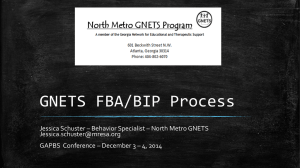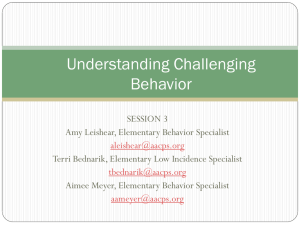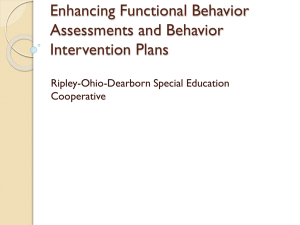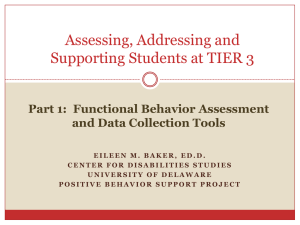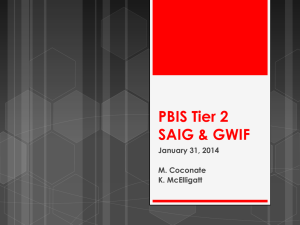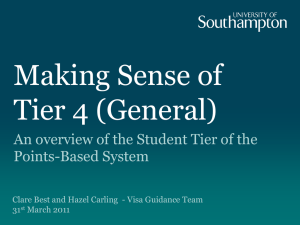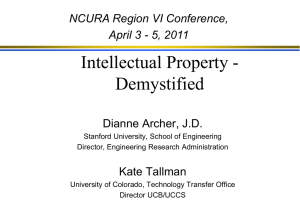PowerPoint - Wisconsin PBIS Network
advertisement
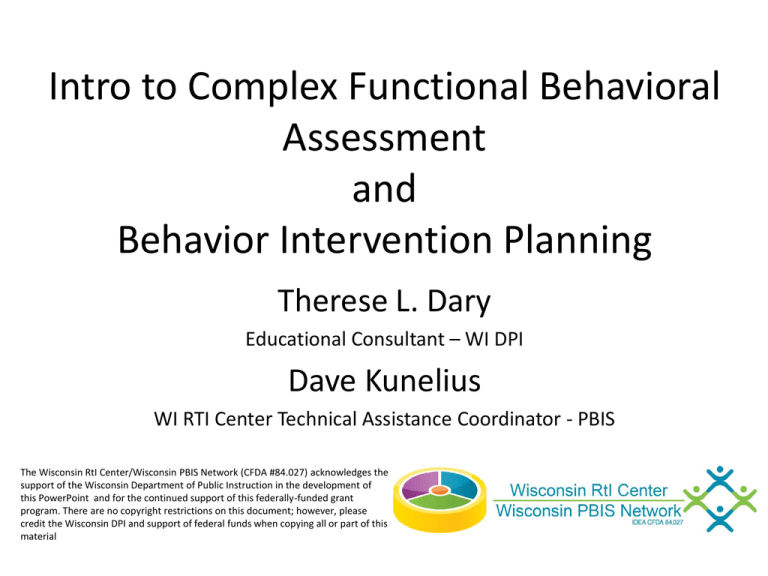
Intro to Complex Functional Behavioral Assessment and Behavior Intervention Planning Therese L. Dary Educational Consultant – WI DPI Dave Kunelius WI RTI Center Technical Assistance Coordinator - PBIS The Wisconsin RtI Center/Wisconsin PBIS Network (CFDA #84.027) acknowledges the support of the Wisconsin Department of Public Instruction in the development of this PowerPoint and for the continued support of this federally-funded grant program. There are no copyright restrictions on this document; however, please credit the Wisconsin DPI and support of federal funds when copying all or part of this material Wisconsin RtI Center Our mission is to support schools through the phases and sustainability of their RtI system implementation. The core reason that the Wisconsin RtI Center exists is to develop, coordinate and provide high-quality professional development and technical assistance… as well as to gather, analyze and disseminate RtI implementation data to enhance the support of schools’ implementation. Training Behavioral Expectations EXPECTATION BE RESPONSIBLE TRAINING SITE Make yourself comfortable & take care of your needs Address question/activity in group time before discussing “other” topics Ask questions BE RESPECTFUL Turn cell phones, beepers, and pagers “off” or to “vibrate” Contribute where possible BE PREPARED Follow up on tasks for next training day Take (and Pass) notes (use Action Plan throughout day) Assumptions and Objectives • Assumptions Participants already conduct brief functional behavioral assessment Participants are facilitating the Functional Behavior Assessment process in their buildings and are working with teams to build behavior support plans for individual students • Objectives Brief overview of entire FBA/BIP process (from Brief to Complex) & where it fits in the 3-Tiered continuum of supports Difference in role of Tier 2 versus Tier 3 FBA/BIP Facilitator Technical aspects of Complex FBA & BIP Review of more intensive FBA tools (FCRM, PBQ, scatter plots, etc.) Introduction of Wraparound Forced-Choice Reinforcement Menu • Find the tool in your folder. • Think back to third grade and answer the questions based on yourself at that time. • Fill it out before you look at the scoring. 10 minutes to complete • Scoring Introductions/Reflection • Introduce yourself to the table or elbow partner Forced-Choice Reinforcement Menu: • When would you use this tool? • Who could you use it with? • How might it benefit the team when writing a behavior plan? FBA/BIP Competing Behavior Pathway Student Strengths 5 6 Desired Behavior 2 4 Setting Event 1 Trigger/Antecedent Problem Behavior(s) 7 Replacement Behavior Adapted from Sugai, G., Lewis-Palmer, T., & Hagan-Burke, S., 2000 Current Consequence 8 3 Maintaining Consequence Function School-Wide Systems for Student Success: A Response to Intervention (RtI) Model Academic Systems Behavioral Systems Tier 3/Tertiary Interventions 1-5% 1-5% Tier 3/Tertiary Interventions •Individual students •Assessment-based •High intensity Tier 2/Secondary Interventions •Individual students •Assessment-based •Intense, durable procedures 5-15% 5-15% Tier 2/Secondary Interventions •Some students (at-risk) •High efficiency •Rapid response •Small group interventions •Some individualizing •Some students (at-risk) •High efficiency •Rapid response •Small group interventions • Some individualizing Tier 1/Universal Interventions 80-90% •All students •Preventive, proactive 80-90% Tier 1/Universal Interventions •All settings, all students •Preventive, proactive Illinois PBIS Network, Revised May 15, 2008. Adapted from “What is school-wide PBS?” OSEP Technical Assistance Center on Positive Behavioral Interventions and Supports. Accessed at http://pbis.org/schoolwide.htm SCHOOL-WIDE POSITIVE BEHAVIOR SUPPORT ~5% ~15% Primary Prevention: School-/ClassroomWide Systems for All Students, Staff, & Settings ~80% of Students Tertiary Prevention: Specialized Individualized Systems for Students with High-Risk Behavior Secondary Prevention: Specialized Group Systems for Students with At-Risk Behavior Positive Behavior Interventions & Supports: A Response to Intervention (RtI) Model Tier 1/Universal School-Wide Assessment School-Wide Prevention Systems Tier 2/ Secondary ODRs, Attendance, Tardies, Grades, DIBELS, etc. Check-in/ Check-out (CICO) Social/Academic Instructional Groups (SAIG) Daily Progress Report (DPR) (Behavior and Academic Goals) Competing Behavior Pathway, Functional Assessment Interview, Scatter Plots, etc. Group Intervention with Individualized Feature (e.g., Check and Connect -CnC and Mentoring) Tier 3/ Tertiary Brief Functional Behavior Assessment/ Behavior Intervention Planning (FBA/BIP) Complex or Multiple-domain FBA/BIP SIMEO Tools: HSC-T, RD-T, EI-T Wraparound Illinois PBIS Network, Revised October 2009 Adapted from T. Scott, 2004 Brief Overview of the Tier 3 FBA/BIP System Focusing on Teaming Teaming at Tier 3 • Tertiary Systems Planning ‘conversation’ Monitors effectiveness of Complex FBA/BIP & Wraparound supports Review data in aggregate to make decisions on improvements to the interventions themselves Students are NOT discussed • Individual Student Teams FBA/BIP Team per student Wraparound Team per student Tertiary System Planning Team • Supported by Tertiary Coach • Review/assess effectiveness of interventions themselves • Work on improving/creating intervention systems, data, practices • Support Complex FBA/BIP & Wraparound facilitators Tier 2/3 Automated Tracking Tool http://www.wisconsinpbisnetwork.org/coaches/resources.html Student-Specific Teams • Wraparound Team: Family of child and all relevant stakeholders invited by family. Wrap facilitators are trained to effectively engage families so that they will see that these teams are created by and for the family, and therefore will want to have a team and actively participate. School staff involved are informed that their presence is uniquely important for this youth and invited to participate. • Individual Youth FBA/BIP Team: Like the wraparound team, this team is uniquely created for each individual child in need of comprehensive planning and the families are critical members of the team. All relevant individuals/staff are invited. Team Development Initiating Tier 3 FBA/BIP Process Prepare for team meetings through individual conversations with core team members (critical first step) The first contact/s with the family should feel different than being invited to a standing/generic meeting (ex. IEP meeting) Gather information on youth strengths & preferences (this will be valuable information for action planning) Team Development (cont.) Tier 3 FBA/BIP Facilitator: Meets with family & stakeholders Gathers perspectives on strengths & needs Assesses safety • Initiates creation of crisis/safety plan if safety is compromised Explains the Tier 3 FBA/BIP process Assists in identifying team members, invites members & facilitates mtg. Summarizes interview information & data review (FBA) into Competing Behavior Pathway and shares with team 3-Tiered System of Support Necessary Conversations (Teams) Universal Team Plans SW & Class-wide supports Universal Support Secondary Systems Team Problem Solving Team Tertiary Systems Team Uses Process data; determines overall intervention effectiveness Standing team; uses FBA/BIP process for one youth at a time Uses Process data; determines overall intervention effectiveness CICO Brief SAIG Group w. individual feature Brief FBA/BIP Sept. 1, 2009 FBA/ BIP Complex FBA/BIP WRAP TEAMING: What Modifications are Needed to your Teaming Process to Ensure both Tertiary Systems & Practices are Used Effectively? Focus on Layering: Differences between Tier 2 & Tier 3 FBA/BIP Based on Research and Practical Experience….. • By the time youth access FBA/BIP intervention, they are already at high-risk of placement change • More youth need FBA/BIP, sooner. • FBA/BIPs are often found in the “file” and viewed as a document. • Many BIPs focus only on consequences (rewards/punishments), omitting supports that make appropriate behavior more likely Identifying Who Needs a FBA/BIP • Kids are referred to an individual problem solving team by the Secondary Systems Team typically when lower-level, Simple Secondary, interventions do not result in adequate progress. Any student not responding adequately to CICO, S/AIG and/or Mentoring etc. (CnC etc.). Request for Assistance made: • Data identifies student as in need (# of ODRs, suspensions, absences, etc..). • Exception to the system: Adult perceives youth as in urgent need (lower-level support not seen as adequate) Brief vs. Complex FBA/BIP • Brief Complex Generic Individual • Individualized Youth Problem solving Team FBA/BIP Team • Meeting time/day usually already determined • Meeting time/day decided by individualized team • Plan developed quickly/easily • Interventions are highly individualized Brief vs. Complex FBA/BIP Brief • Every school has this type of meeting Complex • May be a new type of meeting for schools. Behavior intervention • Interventions/strategies plans address only one address multiple behavior, typically only settings and/or in one setting. behaviors Brief vs. Complex FBA/BIP Brief • SWIS data, Daily Progress Report (DPR) points, Functional Assessment interviews • Effectiveness of system monitored by Secondary Systems Planning Team Complex • SWIS data, Daily Progress Report (DPR) points, Functional Assessment interviews, SIMEO Data, direct observation data, additional tools as needed • Effectiveness of system monitored by Tertiary Systems Planning Team • Data reviewed at least every other week • Data reviewed at least weekly FBA and Special Education Questions to consider: • Do the behaviors significantly interfere with the student’s learning or the learning of others? • Do we suspect this student may have a disability? • Is seclusion and/or restraint reasonably anticipated? • Has this student been suspended or expelled? Do we suspect this student may have a disability? Is conducting an FBA considered part of an evaluation? The IEP Team determines if the FBA is necessary as part of the evaluation in order to determine whether the child has a disability or the extent of special education and related services that are needed. If the IEP Team determines the FBA is part of the evaluation, parent consent must be obtained, as is the case for all data collected in the evaluation process. From Bulletin 06.02: A child who had not been determined eligible for special education is entitled to protection of special education law when the public agency had knowledge that the child was a child with a disability prior to the behavior that precipitated the disciplinary action. A public agency must be deemed to have knowledge when: • The child’s parent expressed concern in writing to supervisory or administrative personnel of the appropriate educational agency, or a teacher of the child, that the child is in need of special education and related services. • The child’s parent requested a special education evaluation of the child. • The child’s teacher, or other personnel of the LEA, expressed specific concerns about a pattern of behavior demonstrated by the child directly to the director of special education of the agency or to other agency supervisory personnel. Is seclusion and/or restraint reasonably anticipated or has it already been used? The first time that seclusion or physical restraint is used on a student, the IEP team must review the student’s IEP to make sure that it contains appropriate positive behavioral interventions, supports, and other strategies to address the behavior, and revise if necessary. At anytime if the IEP team determines that the use of seclusion or restraint may be reasonably anticipated for the student, the IEP must include: • Appropriate positive interventions and supports and other strategies that address the behavioral concerns based on a functional behavioral assessment; and • Clear statements that the use of restraint and/or seclusion may be used as an intervention. Has this student been suspended or expelled? From Bulletin 06.02: Manifestation Determination Within ten school days after the date on which the decision to make a disciplinary change the child’s placement , the public agency, the parent and relevant members of the IEP team must determine whether the conduct is a manifestation of the child’s disability. • If it is determined that the behavior is a manifestation of the student’s disability, an FBA must be conducted and BIP implemented, unless one has been conducted previously. • If a BIP has already been developed, review the BIP and modify it, as necessary, to address the behavior. Starting the Tier 2 FBA/BIP Process • Secondary/Tier 2 systems team: Identifies youth needing FBA/BIP Refers to individual problem solving team • FBA/BIP facilitator (i.e. SW, counselor, psychologist) take lead in using tools & organizing data (FBA) • FBA/BIP facilitator: generates FBA summary based on data shares with problem-solving team (stakeholders) guides team in developing BIP Tools/Data Used for Brief FBA/BIP • Tools: Functional Assessment Interview (FACTS) • Student-Directed Functional Assessment • Family-Directed Functional Assessment Data: • CICO data graphs • SWIS individualized student report • Grades Transitioning to Tier 3 FBA/BIP • Problem-Solving Team reconvenes with stakeholders 4-6 weeks after Brief BIP is implemented • If student did not respond well enough to Brief BIP, the Tier 2 FBA/BIP Facilitator refers youth to Tier 3 FBA/BIP Facilitator or Wrap Facilitator to start Tertiary process (may be same Tier 2 FBA/BIP Facilitator) Tier 3 FBA/BIP Facilitator a) Interviews all stakeholders & reviews data to generate FBA (including previously implemented Brief FBA/BIP) b) Illustrates FBA to the rest of the team through the Competing Behavior Pathway; including hypothesized function; and shares data sources and process used; including interviews that were done c) Leads the team in creating a BIP; making sure all stakeholders have chance to give input and agree with aspects of the plan that require their action/support Other team members/Stakeholders: a) Ask questions for clarification on FBA & come to consensus on hypothesized function or briefly brainstorm alternative function together with FBA/BIP Facilitator b) Using youth’s strengths, helps in creating the BIP; contributing as an ‘implementer’ for parts of BIP where needed (ex. SW may add student to group counseling, Special Education teacher may see youth for after-school tutoring, Counselor may add youth to CICO) The Process for Conducting a FBA 1. Describe the behaviors that are interfering with learning in concrete and observable terms. 2. Collect data from multiple sources to measure the challenging behavior to establish a baseline. 3. Analyze the data and develop a hypothesis that describes why the behavior is occurring, a replacement behavior that leads to the same outcomes, and the conditions that will make it more likely to occur. Next Step: Use this data to develop a Behavior Intervention Plan. Functional behavior assessments should look for patterns to determine the conditions under which the behavior is likely to occur: – When does the behavior occur (and when is it less likely to occur)? – Who does the behavior occur with? – How frequently does it occur? – For how long does the behavior occur? – What happens before behavior? (antecedent) – What happens after behavior? (consequence/outcome) FBA/BIP Competing Behavior Pathway Student Strengths 5 6 Desired Behavior 2 4 Setting Event 1 Trigger/Antecedent Problem Behavior(s) 7 Replacement Behavior Adapted from Sugai, G., Lewis-Palmer, T., & Hagan-Burke, S., 2000 Current Consequence 8 3 Maintaining Consequence Function Setting Event Manipulations Antecedent Manipulations Behavior Manipulations Consequence Manipulations Tier 3 Behavior Intervention Planning • All areas must be addressed: Setting Events Triggering Antecedents Behavior or skills Consequences • All individuals must be involved: Family Non-teaching staff/bus drivers etc. Teachers/administrators Scatter Plots E = Engaged/working A = Using angry words C = Using calming strategies 9/24 9/28 10/1 10/5 10/6 10/8 9:109:15 E E E C E E 9:159:20 E E C C E E 9:209:25 A A C E C E 9:259:30 A A A E A E 9:309:35 A A A E A A 9:359:40 A C A E A A 9:409:45 C C A E A A Scatter Plots E = Engaged/working A = Using angry words C = Using calming strategies 9/24 9/28 10/1 10/5 10/6 10/8 9:109:15 A E E E E E 9:159:20 A E E A E E 9:209:25 A C E A C E 9:259:30 A C C C A E 9:309:35 A C C C A C 9:359:40 C C C E C C 9:409:45 C C C E C C Scatter Plots E = Engaged/working A = Using angry words C = Using calming strategies 9/24 9/28 10/1 10/5 10/6 10/8 9:109:15 A A A C C A 9:159:20 A A A A C A 9:209:25 A A C A C C 9:259:30 C A E C E C 9:309:35 E A E C E E 9:359:40 E C E E E E 9:409:45 E C E E E E Scatter Plot Exercise • Find scatter plot in your folder. • Select a behavior of the trainer or someone else in the room. OPERATIONALIZE the behavior For the purposes of this exercise the behavior should not be a “problem behavior” • Write the behavior on the top of the scatter plot and track behavior. Scatter Plot Exercise ABC Recording Form Observer: Setting: # Time 1 2 Student: Date: Activity/ Task Antecedent Behavior Outcome/ Consequence Considerations for Collecting Data Direct Data Collection Observations over multiple settings and multiple days • Scatter plots • ABC analysis Indirect Data Collection • Student, parent, and teacher interviews • Record reviews • Review of work samples, tests, etc. Summarize the Antecedents and Setting Events: What situations seem to set off the problem behavior? (difficult tasks, transitions, structured activities, small group settings, teacher’s request, particular individuals, etc.) When is the problem behavior most likely to occur? (times of day and days of the week) When is the problem behavior least likely to occur? (times of day and days of the week) Setting Events: Are there specific conditions, events, or activities that make the problem behavior worse? (missed medication, history of academic failure, conflict at home, missed meals, lack of sleep, history or problems with peers, etc.) Describe the Consequences (or outcomes) of the Target Behavior What usually happens after the behavior occurs? • What is the teacher’s reaction? • How do other student’s react? • Is the student sent to the office, does the student get out of doing work, does the student get in a power struggle, etc.) “Sam” • Kindergartener • Aggressive with peers, not participating in activities or following routines, difficulty focusing on any activity ECC program red flagged him due to behavior and lack of academic progress DCFS involved FBA/BIP Competing Behavior Pathway Student Strengths Follow routines Coupons, praise 5 6 Desired Behavior Conflict at home: mornings when not organized for school, not sure who will take Sam to school 4 Setting Event Morning activity when teacher requests that he sit on chair or carpet for structured activity Does not join activity – walks around the classroom poking and pushing kids 2 1 Trigger/Antecedent Problem Behavior(s) Walk to a designated area of classroom 7 Replacement Behavior Adapted from Sugai, G., Lewis-Palmer, T., & Hagan-Burke, S., 2000 Current Consequence Gets a time out to calm down and misses activity Escape 8 3 Maintaining Consequence Function Do we have all of the information we need? 1. Is the behavior clearly defined in observable and measurable terms? 2. Have replacement behaviors that serve the same function and the conditions under which they should occur been identified? 3. Has the data been triangulated using multiple sources and multiple measures over multiple settings? 4. Has a hypothesis been developed based on the data collected which identifies the conditions under which the replacement behavior will occur? Setting Event Manipulations •Walk with “responsible” 4th grade cousin to school. •CICO modified (new adult and more specific goals) Antecedent Manipulations •Re-teach expected behavior for all classroom settings •Additional rating periods for expectations •Individualized positive greeting by teacher in the morning Behavior Manipulations Consequence Manipulations •Teach how to quietly walk to a designated area of the room •Points/ coupons when quietly goes to his “area” •Teach how to sit and complete tasks for 5 minutes up to 10 minutes •Points/ coupons when participates in activities •Does not earn points if puts hands on students Moving from Brief FBA/BIP to Complex FBA/BIP • Team developing plan became more individualized • Additional data tool used—Educational Information Tool (SIMEO) • BIP strategies applied in multiple settings (at school) FBA/BIP Competing Behavior Pathway Student Strengths Coupons, praise Follow routines 5 6 Desired Behavior Conflict at home: problem behavior at home before school Structured academic tasks Does not complete work, throws things, laughs, disturbing others 2 4 Setting Event 1 Trigger/Antecedent Problem Behavior(s) Ask teacher for help 7 Replacement Behavior Adapted from Sugai, G., Lewis-Palmer, T., & Hagan-Burke, S., 2000 Current Consequence Teacher walks over, talks to him and helps him get on task Adult attention 8 3 Maintaining Consequence Function Setting Event Manipulations Cousin involved in CICO process (more encouragement, helping to get DPR home for guardian to see) Antecedent Manipulations •More reteaching for whole class, how to quietly work •Higher rates of praise during activities •Use timer so all kids could see how much time they had for activity Behavior Manipulations • Teach how to ask for help •Teach how to work in close proximity to peers -- sharing supplies and asking for help from peers Consequence Manipulations •Points earn extra playtime of choice at end of class •Planned ignoring of problem behavior (teacher will reward nearby youth) •Reward at home when earns DPR points Data-based Progress Month Average Daily Progress Report points Sept-November (CICO and Mentoring) 32% December-February (Added Brief FBA/BIP) 63% March-May (Moved to Complex FBA/BIP) 70% Educational-Information Tool Dibels Testing 2008/09 Letter Naming Fluency Letter Sound Fluency Beginning BenchmarksAt risk Beginning BenchmarksAt risk Ending BenchmarksEmerging Ending BenchmarksEmerging TEAMING: What modifications are needed to your FBA/BIP System to ensure practices are efficient and effective at Tier 2 & Tier 3? Do we have all of the information we need? 1. Is the behavior clearly defined in observable and measurable terms? 2. Have replacement behaviors that serve the same function and the conditions under which they should occur been identified? 3. Has the data been triangulated using multiple sources and multiple measures over multiple settings? 4. Has a hypothesis been developed based on the data collected which identifies the conditions under which the replacement behavior will occur? Positive Behavior Support Social Competence & Academic Achievement OUTCOMES Supporting Decision Making Supporting Staff Behavior PRACTICES Adapted from “What is a systems Approach in school-wide PBS?” OSEP Technical Assistance on Positive Behavioral Interventions and Supports. Accessed at http://www. Pbis.org/schoolwide.htm ٭ Supporting Student Behavior FBA/BIP Tools 1) Direct Observation • • Formal (recorded) Informal (anecdotal) 2) Interviews, checklists, surveys • • Brief, simple, practical Longer, more complex, use when necessary 3) Archival records • Already exist Additional Data Tools Used for Complex FBA/BIP • • • • Problem-Behavior Questionnaire Forced-Choice Reinforcement Menu Complex FBA Family-Directed Interview Direct observation tools (scatter plot, ABC chart) • SIMEO (IL) Educational Information Tool Student Disposition Tool Recommended Time-frames for Data Review • Simple Secondary: (ex. Check-in Check-out, Social/Academic Instructional Groups) Facilitator reviews bi-weekly, secondary system team only reviews in aggregate two times monthly • Individualized Simple Secondary: (ex. Check-nConnect, Brief FBA/BIP) Facilitator reviews weekly, problem solving team reviews monthly • Tertiary/Complex Individualized Interventions: (ex. FBA/BIP & Wraparound) Facilitator reviews daily, team reviews weekly/biweekly TEAMING: What modifications are needed to your tool menu to ensure efficient and effective data use at Tier 3? When a Complex FBA/BIP is Not Enough • When setting events are too big (challenging, confusing, multi-faceted) • When placement is at-risk (home, school &/or community) • When adults are not getting along • In these situations…Wraparound can help Deciding Which Tertiary Level Intervention is Most Appropriate Complex FBA/BIP (T200): • Brief FBA/BIP was not successful AND • NONE of Wraparound criteria are present Wraparound (T300+): • Youth with multiple needs across home, school, community & life domains • Youth at-risk for change of placement • The adults in youth’s life are not effectively engaged in comprehensive planning (i.e. adults not getting along well) Function Big Need • The purpose/reason for demonstrating a specific type of behavior within a specific context/routine. • The underlying reason preventing successful experiences/interactions in multiple settings/contexts/routines • Specific behaviors have been strengthened by consistent reinforcement. • When a big quality of life need is unmet, it impacts perception/judgment, often resulting in chronic problem behavior. • Family voice is not necessary to identify function of behavior in the school setting. • Family voice is necessary to identify the Big Need for the school setting. • Once Function is correctly identified, putting a plan in place • Once Big Need is identified, it takes can produce rapid behavior a while to achieve and involves change. This can be accomplished action planning across multiple life in a single meeting. domains. Meeting the big need always involves multiple Child & Family Team meetings. Function Big Need • Function is identified through • Big needs are identified through structured interviews focusing on open-ended conversation and use the problem behavior, of SIMEO tools with those engaged antecedents, consequences, and with the youth on a regular basis. setting events • Big Need statements motivate a • Focus is on developing functionfamily to participate on the team based support plan (replacement (know we are working on behavior, antecedent, something ‘bigger’ than specific consequence, and setting event behaviors). supports). • If met, the need will improve • When achieved, situations quality of life for the youth or those improve for the youth or those engaged with the youth on a engaged with the youth on a regular basis (e.g., the family, the regular basis (e.g., the family, the teacher). teacher). Big Need: “Andy needs to feel like he belongs at school” • School Behaviors: Aggressive with peers, excessive absences/tardies, history of academic failure • Other indicators: Family frequently relocated, lack of home school communication, community support needs Starting with FBA would not have been an effective approach—why? Discussing problem behaviors would not have motivated family to participate on team. Probably not the first time schools have approached family in this manner (“let’s talk about behavior”) Open-ended conversation and use of SIMEO tools helped engage family Bigger needs to work on to improve quality of life for youth and family Example of FBA Fidelity Check: Using the ISSET Checklist FBA includes: • Operational definition of problem behavior(s) that is observable & countable. • Statement about relation between events that precede (trigger) problem behavior and/or events that follow and maintain the behavior. BIP includes: • Operational definition of problem behavior (or attached FBA that included the operational definition) • Statement about the relation between FBA results and the BIP • Statement that identifies at least 1 strategy for preventing the problem behavior • At least 1 strategy for minimizing reinforcement of problem behavior • At least 1strategy for reinforcing the use of the desired/alternative behaviors • Identifies a safety plan for preventing physical harm to self or others • A formal and regular (at least twice a month) system for assessing the fidelity with which the plan of support is being implemented • A formal and regular (at least twice a month) system for assessing the impact of the plan on student outcome. Activity: FBA/BIP Systems Using the Tier 2/Tier 3 Guiding Questions, brainstorm on the following: • Do you have a brief & a complex version of FBA/BIP support? • How many youth are receiving each? (tracking tool) • Are youth responding to these supports? • Complete section Tertiary I: Complex FBA/BIP Report Out: Wrap-up & Next Steps for Action Planning • What parts of your FBA/BIP system are working best? Why? • What needs to be added/changed (systems, data, practices)? • What info needs to be gathered? • What are next steps? • Who will take lead? • Timeline? Questions? References Burchard, J.D., Bruns, E.J. & Burchard, S.N., (2002). The Wraparound approach. In B. Burns & K. Hoagwood (Eds.). Community treatment for youth: Evidence-based interventions for severe emotional and behavioral disorders. New York: Oxford University Press. Crone, D.A. & Horner, R.H. (2003). Building positive behavior support systems in schools: Functional behavioral assessment. New York: Guilford. Crone, D.A., Horner, R.H. & Hawken, L.S. (2004). Responding to problem behavior in schools: The behavior education program. New York: Guilford. Day, H.M., Horner, R.H., & O’Neill, R.E. (1994). Multiple functions of problem behaviors: Assessment and intervention. Journal of Applied Behavior Analysis, 27, 279-289. Eber, L. (2005). Wraparound: description and case example. In Sugai, G. & Horner, R. (Eds.), Encyclopedia of Behavior Modification and Cognitive Behavior Therapy: Educational Applications. 1601-1605. Thousand Oaks: Sage. Eber, L., Sugai, G., Smith, C.R., & Scott, T. (2002). Wraparound and positive behavioral interventions and supports in the schools. Journal of Emotional and Behavioral Disorders, 10, 171-181. References Freeman, R., Eber, L., Anderson, C., Irvin, L., Horner, R., Bounds, M., et al. (2006). Building inclusive school cultures using school-wide positive behavior support: Designing effective individual support systems for students with significant disabilities. Research and Practice for Persons with Severe Disabilities, 31, 4-17. Scott, T., & Eber, L. (2003). Functional assessment and wraparound as systemic school processes: Primary, secondary, and tertiary systems examples. Journal of Positive Behavior Supports, 5, 131-143. Sugai, G., Lewis-Palmer, T., & Hagan-Burke, S. (2000). Overview of the functional behavioral assessment process. Exceptionality, 8, 149-160. Turnbull, A., Edmonson, H., Griggs, P., Wickham, D., Sailor, W., Freeman, R., et al., (2002). A blueprint for schoolwide positive behavior support: Implementation of three components. Exceptional Children, 68, 377-402. Competing Behavior Pathways Model Sleep Setting Medicine Event(s) Impairment Peer Antecedent Comment Conscious choice to ignore, regulation Desired skill, appropriate Behavior comment Completes Ideal in all work Outcome class Behavior Threats, Interferes w/ loud voice Learning Work Current output is Outcome reduced Allowed Taught Goesto toleave use Replacement toindependent regulation get a drinkskill of (Taught) reading when water inarea hallway and writes inBehavior the forinhallway drink journal
